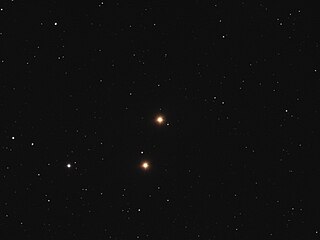
R Coronae Borealis is a low-mass yellow supergiant star in the constellation of Corona Borealis. It is the prototype of the R Cor Bor class of variable stars, which fade by several magnitudes at irregular intervals. R Coronae Borealis itself normally shines at approximately magnitude 6, just about visible to the naked eye, but at intervals of several months to many years fades to as faint as 15th magnitude. Over successive months it then gradually returns to its normal brightness, giving it the nickname "reverse nova", after the more common type of star which rapidly increases in brightness before fading.
KW Sagittarii is a red supergiant, located approximately 1,900 parsecs away from our Sun in the direction of the constellation Sagittarius. It is one of the largest known stars. If placed at the center of the Solar System, the star's surface would engulf Mars.

An R Coronae Borealis variable is an eruptive variable star that varies in luminosity in two modes, one low amplitude pulsation, and one irregular, unpredictably-sudden fading by 1 to 9 magnitudes. The prototype star R Coronae Borealis was discovered by the English amateur astronomer Edward Pigott in 1795, who first observed the enigmatic fadings of the star. Only about 150 RCB stars are currently known in our Galaxy while up to 1000 were expected, making this class a very rare kind of star.

S Coronae Borealis is a Mira variable star in the constellation Corona Borealis. Its apparent magnitude varies between 5.8 and 14.1, with a period of 360 days—just under a year. Within the constellation, it lies to the west of Theta Coronae Borealis, and around 1 degree southeast of the eclipsing binary star U Coronae Borealis.
V725 Sagittarii is a variable star in the southern constellation of Sagittarius. As recently as a century ago, it was a Population II Cepheid; its transformation was documented by Henrietta Swope beginning in 1937, and is one of the most exciting and instructive events in variable-star astronomy. The star has varied between apparent visual magnitude 12.3 and 14.3.
U Aquarii, abbreviated U Aqr, is a variable star in the equatorial constellation of Aquarius. It is invisible to the naked eye, having an apparent visual magnitude that ranges from 10.6 down to as low as 15.9. Based on parallax measurements, the distance to this star is approximately 38 kly (12 kpc). In 1990, W. A. Lawson and associates provided a distance estimate of 43 kly (13.2 kpc) based on the assumption of a bolometric magnitude of −5. It appears to lie several kiloparsecs below the galactic plane, and thus may belong to an old stellar population.

HD 168607 is a blue hypergiant and luminous blue variable (LBV) star located in the constellation of Sagittarius, easy to see with amateur telescopes. It forms a pair with HD 168625, also a blue hypergiant and possible luminous blue variable, that can be seen at the south-east of M17, the Omega Nebula.
HD 102350 is a single star in the constellation Centaurus. It has a yellow hue and is visible to the naked eye with an apparent visual magnitude of 4.11. The distance to this star is approximately 390 light years based on parallax, but it is drifting closer with a radial velocity of −3 km/s. It has an absolute magnitude of −1.51.
Gamma Coronae Borealis, Latinized from γ Coronae Borealis, is a binary star system in the northern constellation of Corona Borealis. It is visible to the naked eye with an apparent visual magnitude of 3.83. Based upon an annual parallax shift of 22.33 mas as seen from Earth, it is located about 146 light years from the Sun. The system is moving closer to the Sun with a radial velocity of about −15 km/s.
Theta Coronae Borealis, Latinized from θ Coronae Borealis, is a binary star system in the constellation Corona Borealis. It shines with a combined apparent visual magnitude of 4.13. There are two components: Theta Coronae Borealis A is of apparent magnitude 4.16, while Theta Coronae Borealis B lies around 1 arcsecond distant and has an apparent magnitude of 6.29. The system is located around 375 light-years from Earth, as estimated from its parallax of 8.69 milliarcseconds. It is estimated to be 85 million years old, with the primary star expected to remain on the main sequence burning its core hydrogen for another 75 million years and the secondary around 500 million years. Both stars will cool and expand once their core hydrogen is exhausted, becoming red giants.

Epsilon Coronae Borealis, Latinized from ε Coronae Borealis, is a multiple star system in the constellation Corona Borealis located around 230 light-years from the Solar System. It shines with a combined apparent magnitude of 4.13, meaning it is visible to the unaided eye in all night skies except those brightly lit in inner city locations. It is an orange giant around 1.7 times as massive as the Sun of spectral type K2III, which has exhausted its core fuel supply of hydrogen and swollen to 21 times the Sun's diameter and 151 times its luminosity. That is, Epsilon Coronae Borealis's diameter is about one-quarter of Mercury's orbit. Its surface temperature has been calculated to be 4365 ± 9 K, or 4406 ± 15 K. It is thought to be around 1.74 billion years old.
Delta Coronae Borealis, Latinized from δ Coronae Borealis, is a variable star in the constellation Corona Borealis. Its apparent magnitude varies regularly between apparent magnitude 4.57 and 4.69, and it is around 170 light-years distant.

Lambda Coronae Borealis, its name Latinised from λ Coronae Borealis, is a single star in the northern constellation of Corona Borealis. In publications it is also identified as HR 5936 and HD 142908. It has a yellow-white hue and is dimly visible to the naked eye with an apparent visual magnitude of 5.43. The star is located at a distance of 136 light years based on parallax, but is drifting closer with a radial velocity of −12 km/s.

V1073 Scorpii is a variable star in the constellation Scorpius. It has a non-Greek Bayer designation of k Scorpii. The star has a blue-white hue and is visible to the naked eye with an apparent visual magnitude that fluctuates around +4.87. Parallax measurements yield a distance estimate of approximately 2,920 ly (896 pc) from the Sun, and it is drifting further away with a radial velocity of +7 km/s. It has an absolute magnitude of −6.8

UY Scuti (BD-12°5055) is a red supergiant star in the constellation Scutum. It is considered one of the largest known stars by radius and is also a pulsating variable star, with a maximum brightness of magnitude 8.29 and a minimum of magnitude 10.56. It has an estimated radius of 1,708 solar radii (1.188×109 kilometres; 7.94 astronomical units), thus a volume nearly 5 billion times that of the Sun. It is approximately 2.9 kiloparsecs (9,500 light-years) from Earth. If placed at the center of the Solar System, its photosphere would at least engulf the orbit of Jupiter.
RS Telescopii, abbreviated RS Tel, is a variable star in the southern constellation of Telescopium. It is a dim star with an apparent visual magnitude of 10.67, which is much too faint to be visible without a telescope. The variability of this star was discovered by Evelyn F. Leland and announced by Edward C. Pickering in 1910. It was first studied by Cecilia H. Payne in 1928 at the Harvard College Observatory.

Nu1 Coronae Borealis is a solitary, red-hued star located in the northern constellation of Corona Borealis. It is faintly visible to the naked eye, having an apparent visual magnitude of 5.20. Based upon an annual parallax shift of 5.0 mas, it is located roughly 650 light years from the Sun. At that distance, the visual magnitude is diminished by an extinction of 0.1 due to interstellar dust. This object is drifting closer with a radial velocity of −13 km/s.
Sigma Coronae Borealis is a star system in the constellation of Corona Borealis. It is a quintuple star system containing three sunlike main-sequence stars and two other low-mass stars. The combined visual magnitude is 5.3 and the system lies 74 light years from Earth. σ CrB A is the variable star TZ Coronae Borealis.
Upsilon Coronae Borealis, Latinized from υ Coronae Borealis, is a solitary star in the northern constellation of Corona Borealis. It is a white-hued star that is dimly visible to the naked eye with an apparent visual magnitude of 5.78. The distance to this object is approximately 630 light-years based on parallax.
S Apodis is an R Coronae Borealis variable star located in the far southern constellation Apus. These are extremely hydrogen-deficient supergiants thought to have arisen as the result of the merger of two white dwarfs; fewer than 100 have been discovered as of 2012. Located around 13,000 light-years distant, it shines with a luminosity approximately 960 times that of the Sun and has a surface temperature of 3916 K.








